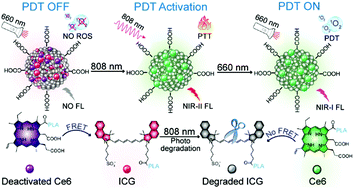A biodegradable nano-photosensitizer with photoactivatable singlet oxygen generation for synergistic phototherapy†
Abstract
Photodynamic therapy (PDT) is a promising method for cancer therapy and also may initiate unexpected damages to normal cells and tissues. Herein, we develop a near-infrared (NIR) light-activatable nanophotosensitizer, which shows negligible phototoxicity before photoactivation to improve the specificity of PDT. The nanophotosensitizer is prepared by indocyanine green carboxylic (ICG), Chlorin e6 (Ce6), and biodegradable poly (lactic acid) (PLA) and poly (lactic-co-glycolic acid) (PLGA), and all these materials have been approved by the Food and Drug Administration. Initially the phototoxicity of Ce6 is effectively inhibited by ICG through fluorescence resonance energy transfer (FRET). Upon 808 nm laser activation, ICG generate hyperthermia for photothermal therapy (PTT) and simultaneously is degraded due to the inherently poor photostability. The FRET is disrupted and followed by the recovery of phototoxicity of Ce6 for PDT. We investigated the photoactivation and the resulting phototherapy by cellular assays and mouse models, which indicate a superior synergistic treatment effect and selective PDT activated by near-infrared 808 nm light. This study presents a promising strategy for activatable and synergistic phototherapy with minimal damage to normal tissues.



 Please wait while we load your content...
Please wait while we load your content...